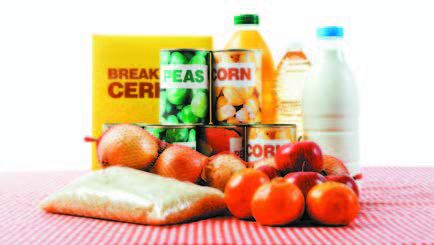There is a growing body of research suggesting high intake of processed foods is associated with various health problems, especially when those foods are highly—or ultra—processed. Many public health guidelines, from the Dietary Guidelines for Americans to World Health Organization recommendations, encourage limiting intake of processed foods. But what, exactly, are processed foods? (See “What is ‘Processing?’ on page 2 of this Special Supplement.) Are all processed foods unhealthy choices? And how can we avoid them when they are all around us? Knowledge is the key to making the best choices for your health.
Processing and Health. “Processing makes our foods edible, safe from bacteria, and shelf-stable so we can ship it all around the world,” says Dariush Mozaffarian, MD, DrPH, dean for policy at the Freidman School of Nutrition Science and Policy and editor-in-chief of Tufts Health & Nutrition Letter. Some food processing is unquestionably responsible for benefits to human health. “Historically, processing was critical for preservation and survival,” says executive editor Alice H. Lichtenstein, DSc, senior scientist and director of the Cardiovascular Nutrition lab at the HNRCA and executive editor of this newsletter. “For example, some New Englanders would have been developed scurvy without foods like sauerkraut.”
Unfortunately, modern food processing is associated with the growing burden of diet-related disease. Ultraprocessed foods in particular are associated with overweight, obesity, type 2 diabetes, and high blood pressure, all of which are risk factors for cardiovascular disease, the leading cause of death in the U.S. and worldwide. High intake of processed meats is associated with increased risk of colorectal cancer. A recent study found a significant association between level of ultraprocessed food consumption and risk for chronic kidney disease.
It has been suggested that food processing is a driver of the obesity epidemic. In one study designed to test if processing plays a role in weight gain, researchers housed 20 healthy, overweight adults in a metabolic ward. They offered them one diet made up almost exclusively of ultraprocessed foods for 14 days, and another of mostly unprocessed foods for another 14 days. They were provided with the same number of calories and amount of fat, carbohydrate, protein, fiber, sugars, and sodium, and told to eat as much or as little as they liked at each meal. Yet, unintentionally, participants consumed about 500 more calories each day when on the ultraprocessed diet versus the unprocessed diet. This led to an average weight gain of two pounds on the ultraprocessed diet, and a loss of two pounds on the unprocessed diet, in just two weeks.
Even organic foods can be ultraprocessed. A study recently conducted in France classified 74 percent of all conventional foods and 53 percent of organic foods as ultraprocessed. (See “Common Ingredients in Ultraprocessed Foods” on page 3 of this Special Supplement.)
Helpful and Harmful. “Food processing is a mixed bag,” says Lichtenstein. “Some types, such as pasteurization, refrigeration, and freezing, have dramatically reduced food waste and the risk of foodborne illness. Other types have had mixed effects. We need to learn how to keep and increase the benefits of food processing while reducing the risks.”
Processing preserves food, can increase digestibility and nutrient availability, and sometimes changes the nutrient profile of the food. Let’s take a closer look at some of the benefits and harms of these key impacts of food processing:
- Preservation: Heating (including pasteurization and canning), cooling, freezing, fermenting, curing, and addition of salt and sugar are all processing methods that preserve our food.
Pros: Preservation extends shelf life, reduces food waste, and has contributed to reducing hunger and improving nutrition worldwide. Heating to a high enough temperature kills most disease-causing microorganisms and degrades enzymes that contribute to spoilage. The application of heat known as pasteurization kills harmful bacteria like Salmonella, Listeria, and E. coli, which cause potentially life-threatening diarrhea, vomiting, and other symptoms of what’s commonly known as “food poisoning.” It also kills bacteria that cause tuberculosis, diphtheria, scarlet fever, and other diseases that can be transmitted in food. The heat used in canning likewise kills bacteria. High pressure processing can be used to kill microorganisms as well.
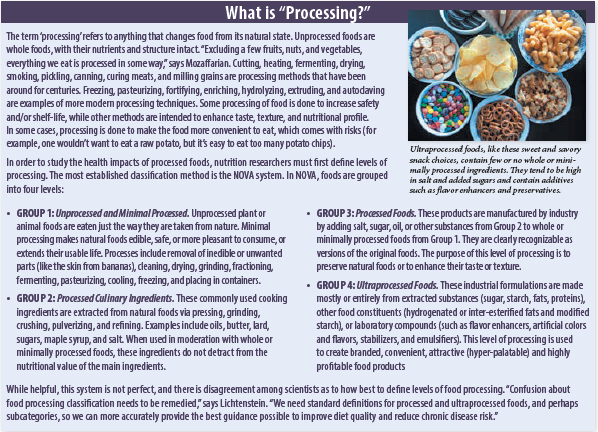
Freezing preserves foods without degrading any nutrients. Freezing fruits and vegetables, for example, locks in nutrients at the peak of freshness and makes these healthful foods available year-round at affordable prices.
Fermentation, another type of food processing, has been associated with health benefits. A randomized, controlled trial conducted in 2021 fed participants a diet high in fermented foods like yogurt, kefir (a yogurt drink), cottage cheese, kimchi (fermented cabbage), and kombucha tea. This diet led to an increase in overall microbial diversity in the gut (which is considered good for overall health) with stronger effects from larger servings. Researchers also saw a decrease in inflammatory markers in the fermented food group. These findings suggest including fermented foods in a healthy dietary pattern may help decrease risk for diseases associated with chronic inflammation (such as arthritis, diabetes, and cardiovascular disease) by supporting a healthy gut microbiome.
Cons: The addition of salt preserves food, but too much salt intake raises blood pressure, increasing the risk for cardiovascular disease. Sugar is also an effective preservative, but too much added sugar, like added salt, is known to be harmful to health. The addition of nitrates and nitrites in the curing of meats like deli meats, sausage, bacon, and salami increases risk for colon cancer. (Note that products marked “no nitrates or nitrites added” still contain nitrites from an alternate form, such as cultured celery juice or sodium nitrate. The total amount in some of these products can be higher than in conventionally cured meats.) Much less is known about the health impacts of preservatives such as benzoic acid, potassium nitrate, and sodium benzoate.
- Changes in Nutrient Profile: Some forms of processing, including enrichment, fortification, heating, and milling, increase or decrease the amount of a nutrient or nutrients in the food.
Pros: Fortification adds vitamins and minerals to a food to make up for dietary shortfalls and improve public health. “Fortifying milk with vitamin D and salt with iodine, and replacing B vitamins lost during refining of grains has virtually eliminated nutrient deficiency diseases in the U.S.,” says Lichtenstein. The fortification of table salt with iodine in the 1920s was a huge leap forward in public health, reducing the nearly endemic incidence of goiter in some parts of the U.S. More recently, adding folic acid to refined flour has contributed to a decrease in the rate of infants born with neural tube defects. Fortification has been criticized for the potential to lead to over-consumption of specific nutrients, although data so far indicate harm from over-consumption is rare. Enrichment adds vitamins and minerals to processed grain products to replace those lost in processing. (We cannot, however, replace all the nutrients that are lost.)
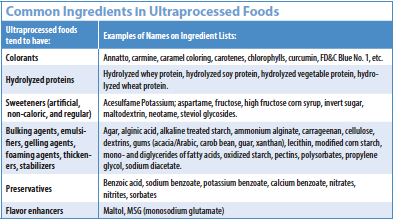
Cons: Exposure to heat can degrade some vitamins (like vitamin C), but this rarely decreases nutrient content enough to impact overall health and nutrition. When grains are milled, the bran and germ are stripped away, removing fiber, B vitamins, and other health-promoting bioactive compounds.
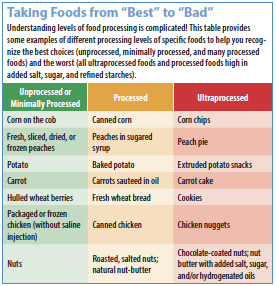
- Increased Digestibility and Absorption: Heating, refining, extrusion, and hydrolysis are examples of processes that make nutrients more digestible.
Pros: Methods like heating break down some of the fibers and cell walls, making foods easier to digest. This decreases the energy needed to digest food while increasing nutrient uptake. The ability to cook food has been extremely important to human growth and survival throughout history. Modern methods like hydrolysis also increase digestibility. Hydrolysis breaks the bonds of large, complex molecules to form smaller ones that are easier for the gut to handle. Hydrolyzing protein, for example, breaks the protein molecule into individual monopeptides (single amino acids) and dipepetides (two amino acids bonded together) that can be directly absorbed. This saves the body the work of digesting the protein, leading to more rapid absorption, which is beneficial in certain cases. Hydrolyzed protein can be helpful for people with digestive disorders, conditions effecting the pancreas (including pancreatic cancer), and infants with food protein allergies or intolerances. It has become popular with athletes and body builders as a way of getting protein to muscles quickly for recovery after intense workouts. “There are currently no data that extra protein after exercise increases muscle or leads to faster recovery,” says Lichtenstein.
Cons: Breaking down the natural food matrix too much can cause food components to be absorbed more quickly than the body can process them. Many of these processing methods also remove beneficial nutrients like fiber. Refining of grains and other starches breaks down the food matrix, the naturally occurring cell structure, making starches and sugars too easy to absorb. “This leads to rapid digestion of the remaining starch (which is essentially 100 percent glucose) in the mouth, stomach, and small intestine,” says Mozaffarian, “shuttling a burst of glucose to our cells while simultaneously starving the beneficial bacteria in our large intestines of fiber. The intact food matrix is a key part of why starches in whole or minimally processed foods, like beans and vegetables, are associated with better health outcomes than white bread.” Additionally, digestion of starch, sugars, and proteins that is too rapid can lead to excess fat production by the liver. Non-alcoholic fatty liver disease (NAFLD) is one of the most common causes of liver disease in the United States, affecting almost a quarter of the population. “This is a good reason to go easy on protein powders and the hydrolyzed protein being added to many food products,” says Lichtenstein.
- Cook at home. Aim to buy unprocessed and minimally processed ingredients and cook at home as much as possible.
- Limit ultraprocessed foods. Avoid foods with ingredient lists that contain numerous additives and few or no minimally processed ingredients.
- Understand benefits. Many forms of processing, like pasteurization, freezing, fermentation, and heating, result in no harms and provide significant health benefits.
- Check ingredients. Limit salt, added sugar, and refined starches in the foods you eat and buy. Nutrition Facts labels list sodium and added sugars. Refined flour is listed in the ingredients as “enriched.”
- Use the Ratio. When buying packaged grain foods, choose those with at least one gram of fiber for every 10 grams of carbohydrate per serving.
“Scientists are just starting to uncover the mechanisms for harms of highly processed foods,” says Mozaffarian. “Based on evidence to date, the major harmful factors seem to be too much refined starch and sugar, added salt and (outside the U.S.) trans fats, and the removal of healthy components like fiber (which serves as a prebiotic for our gut microbiome) and phenolics (the thousands of trace protective nutrients in foods like olive oil, cocoa, blueberries, apples, and green tea).”
We know much less about the long-term health effects of all the trace additives in foods, like emulsifiers, stabilizers, thickening agents, and the chemical byproducts of packaging. “Some experiments in animals suggest these common additives could also have harms,” says Mozaffarian, “but much more research is needed. It’s unfortunate we know so little about many of the most common processing methods used in food.”
What to Do. Mozaffarian encourages buying ingredients and cooking at home whenever possible.Whether you’re cooking at home, getting takeout, or on the go, try to emphasize minimally processed foods like fruits, vegetables, nuts, seeds, legumes, whole grains, fish, and yogurt. “Understand and consider what has been done to the foods you eat,” says Lichtenstein. “Focus on your overall dietary pattern. The biggest losses to healthfulness occur not from occasionally eating one ultraprocessed food, but from displacing most whole and minimally processed foods with ultraprocessed foods. Remember that processing can be good—like freezing berries, which makes them available year-round—or bad—like fruit rolls, which have lost their intact structure and fiber and often have added sugar.”
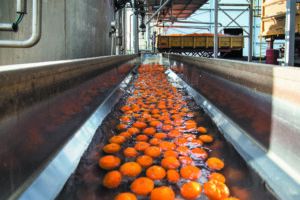
Washing is a form of processing that does not impact the nutritional value of a natural food.
There are some significant benefits to processed foods for modern life that shouldn’t be discounted, including longer shelf life, convenience, and food safety. “It’s time for the food industry and government to invest in the science of how to optimally process foods,” says Mozaffarian. “Then we can keep the benefits and minimize the harms.”
























